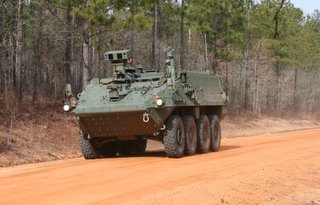Robot Convoy Delivers
By Larry Edmond
FORT GORDON, Ga. (Army News Service) -- Engineers conducting show-and-tell with a 20-ton robot on the last day of two weeks of trials on Fort Gordon were cautiously optimistic.
The system in testing at Fort Gordon is the robotic follower program. This program seeks to develop robots that can conduct convoy operations. One of the vehicles is called the CAT - short for crew integration and automation test bed. It serves as the manned leader vehicle.
The other vehicle serves as an unmanned follower in a convoy.
"Yesterday we ran a 100-mile test where the lead vehicle was being driven manually and the robot was following,” Jeff Jaczkowski, TARDEC electrical engineer and manager, said. “We did this successfully where the average speed was about 22 miles per hour. You may think that 22 miles per hour is not that fast when operational convoys are going 60 to 70 miles per hour. But you have to take into account that we did 68 right turns.
Pointing to the bristling array of sensors on the vehicles, Jaczkowski said these vehicles incorporate second-generation ladar-laser radar, forward-looking infrared sensors, and advanced computers to handle autonomous navigation.
For the autonomous follower, engineers are going beyond Global Positioning Systems to link terrain data from the lead vehicle back to the follower vehicle to augment data the follower vehicle gathers from on-board sensors.
"The idea is to pass electronic bread crumbs from the manned lead vehicle back to the autonomous follower vehicle, and provide high-level proofing of the follower's path so the follower avoids areas that might impede or confuse its autonomous navigation system, while requiring only a minimum of human intervention and control from the lead vehicle," Jaczkowski said.
Soldiers will remain in the vehicles for now, but by placing a vehicle on auto-pilot, the driver will be able to perform other duties or rest.
The long-term objective is to create dedicated unmanned ground vehicles.
In the tests being conducted on Fort Gordon, the lead vehicle develops a path along a route that it transmits to the follower vehicle that can follow the path immediately or weeks later.
The group will continue testing Feb. 24 to March 10, Jaczowski said.
The United States Army News Service
FORT GORDON, Ga. (Army News Service) -- Engineers conducting show-and-tell with a 20-ton robot on the last day of two weeks of trials on Fort Gordon were cautiously optimistic.
The system in testing at Fort Gordon is the robotic follower program. This program seeks to develop robots that can conduct convoy operations. One of the vehicles is called the CAT - short for crew integration and automation test bed. It serves as the manned leader vehicle.
The other vehicle serves as an unmanned follower in a convoy.
"Yesterday we ran a 100-mile test where the lead vehicle was being driven manually and the robot was following,” Jeff Jaczkowski, TARDEC electrical engineer and manager, said. “We did this successfully where the average speed was about 22 miles per hour. You may think that 22 miles per hour is not that fast when operational convoys are going 60 to 70 miles per hour. But you have to take into account that we did 68 right turns.
Pointing to the bristling array of sensors on the vehicles, Jaczkowski said these vehicles incorporate second-generation ladar-laser radar, forward-looking infrared sensors, and advanced computers to handle autonomous navigation.
For the autonomous follower, engineers are going beyond Global Positioning Systems to link terrain data from the lead vehicle back to the follower vehicle to augment data the follower vehicle gathers from on-board sensors.
"The idea is to pass electronic bread crumbs from the manned lead vehicle back to the autonomous follower vehicle, and provide high-level proofing of the follower's path so the follower avoids areas that might impede or confuse its autonomous navigation system, while requiring only a minimum of human intervention and control from the lead vehicle," Jaczkowski said.
Soldiers will remain in the vehicles for now, but by placing a vehicle on auto-pilot, the driver will be able to perform other duties or rest.
The long-term objective is to create dedicated unmanned ground vehicles.
In the tests being conducted on Fort Gordon, the lead vehicle develops a path along a route that it transmits to the follower vehicle that can follow the path immediately or weeks later.
The group will continue testing Feb. 24 to March 10, Jaczowski said.
The United States Army News Service


0 Comments:
Post a Comment
Subscribe to Post Comments [Atom]
<< Home